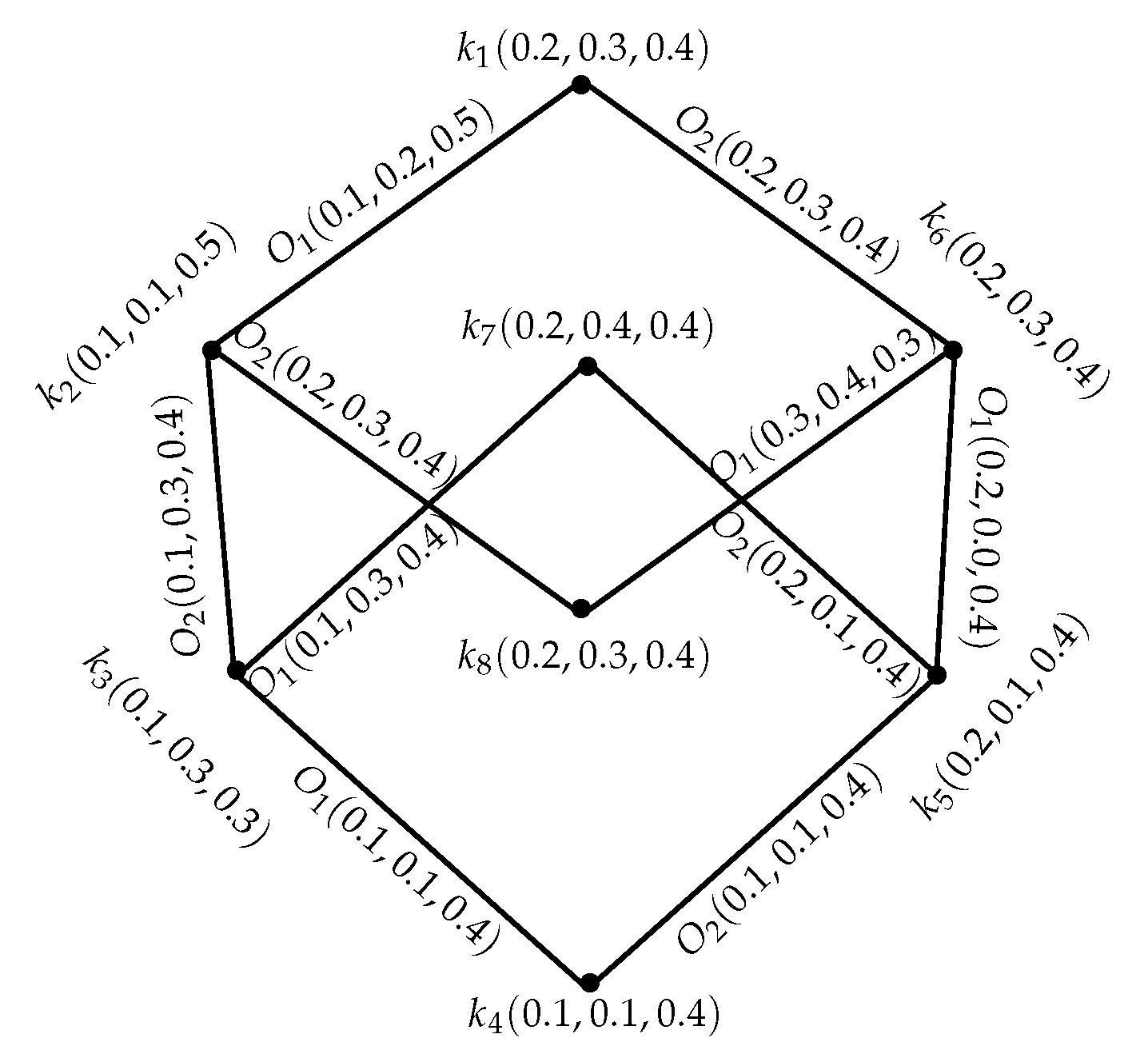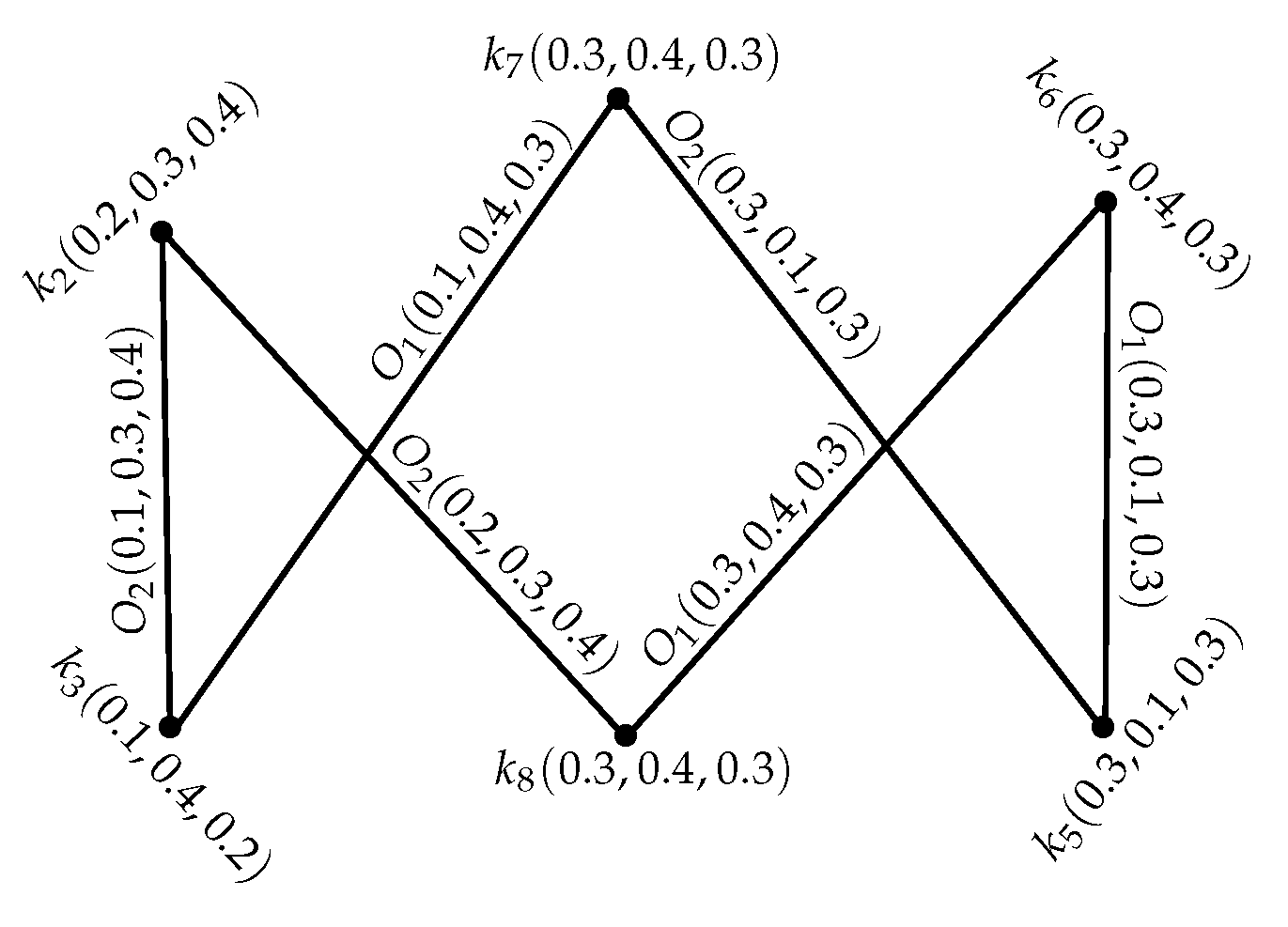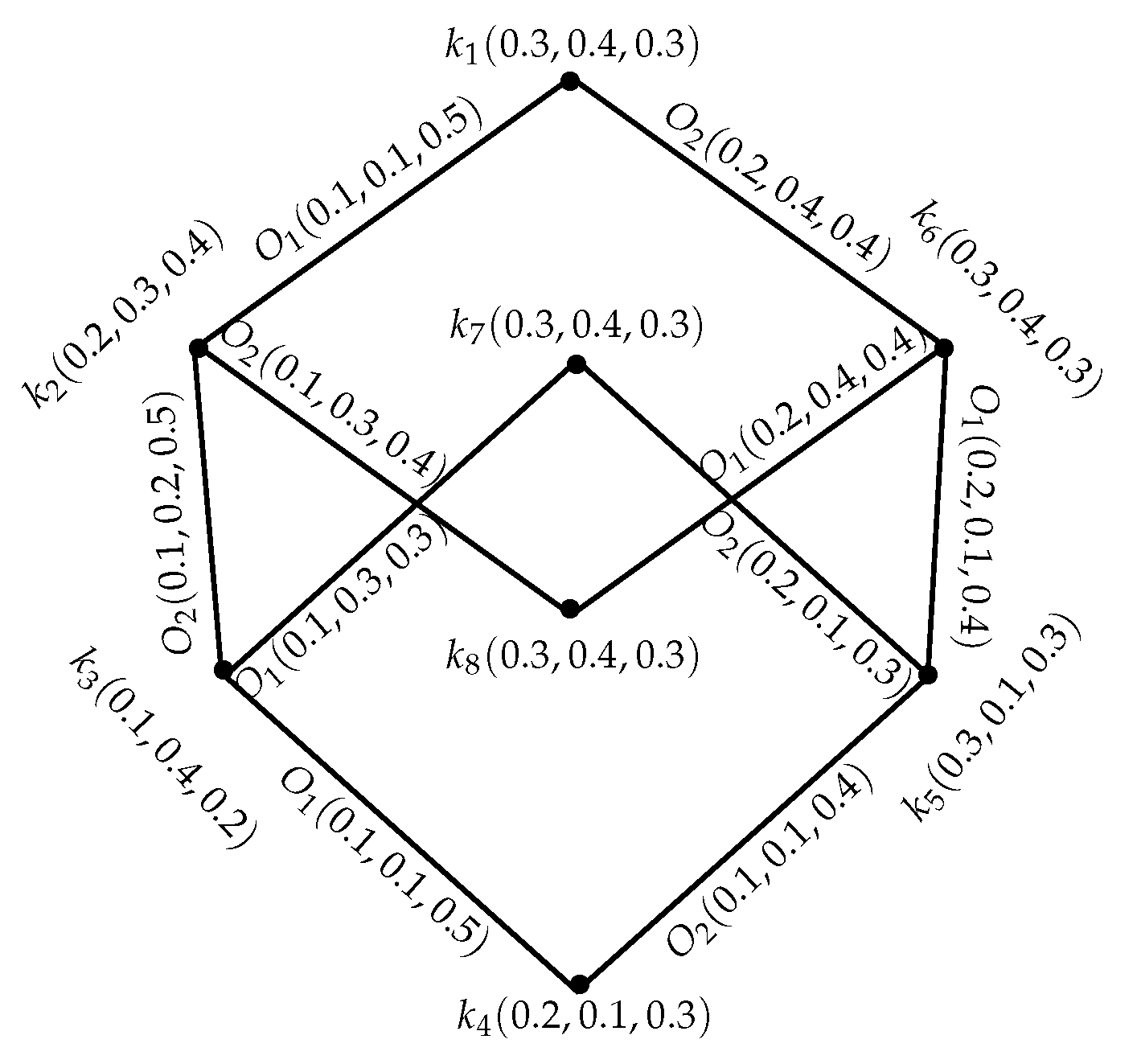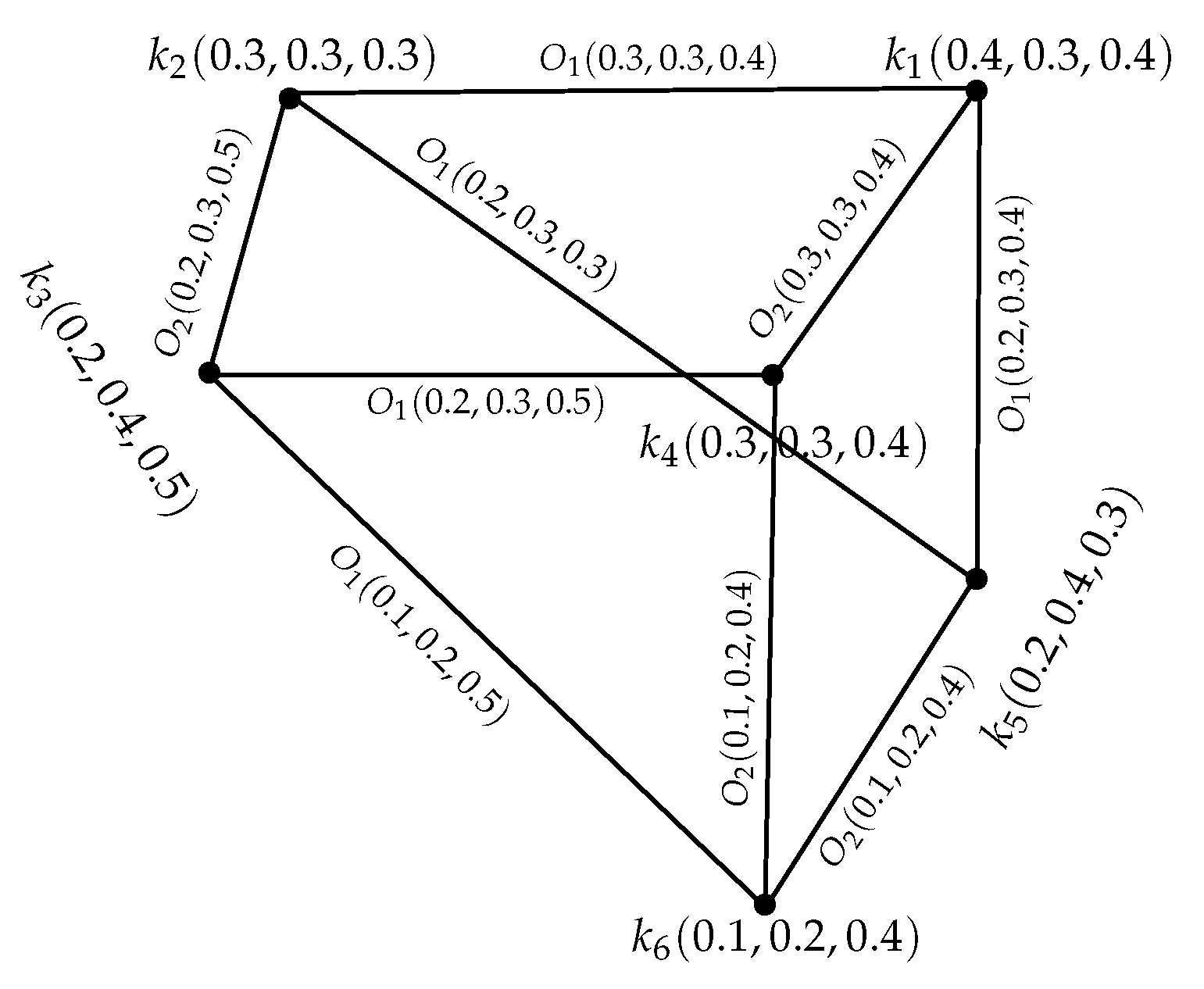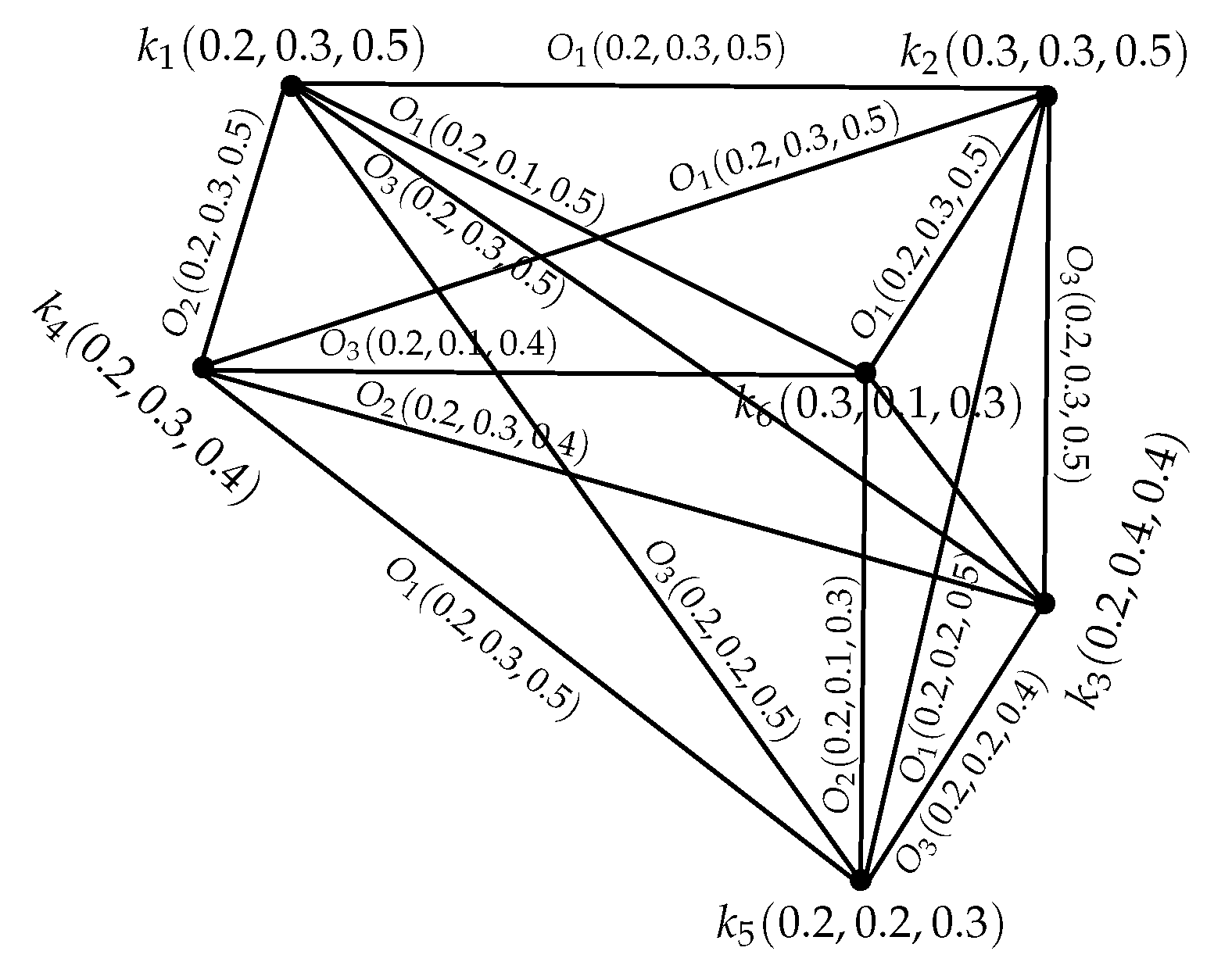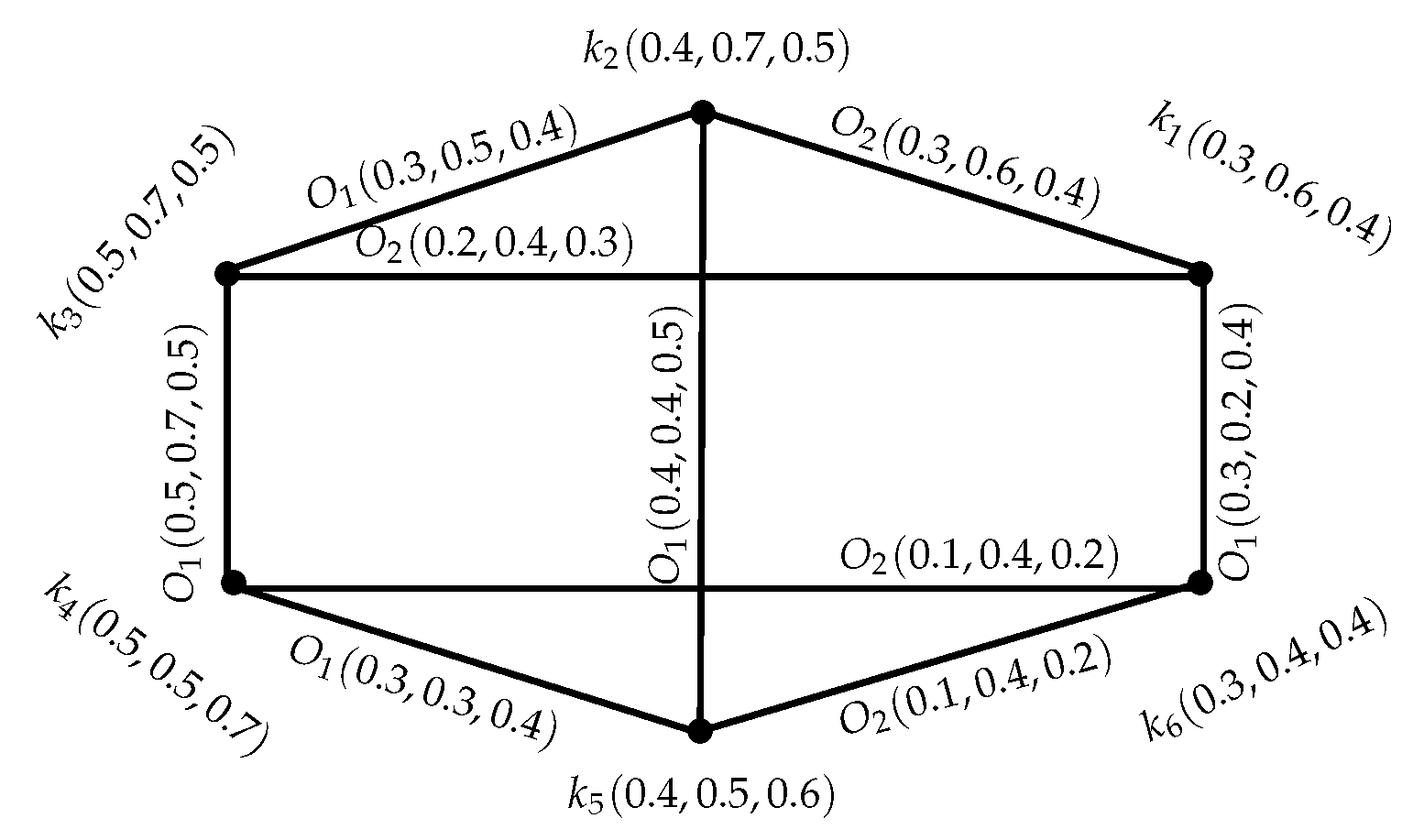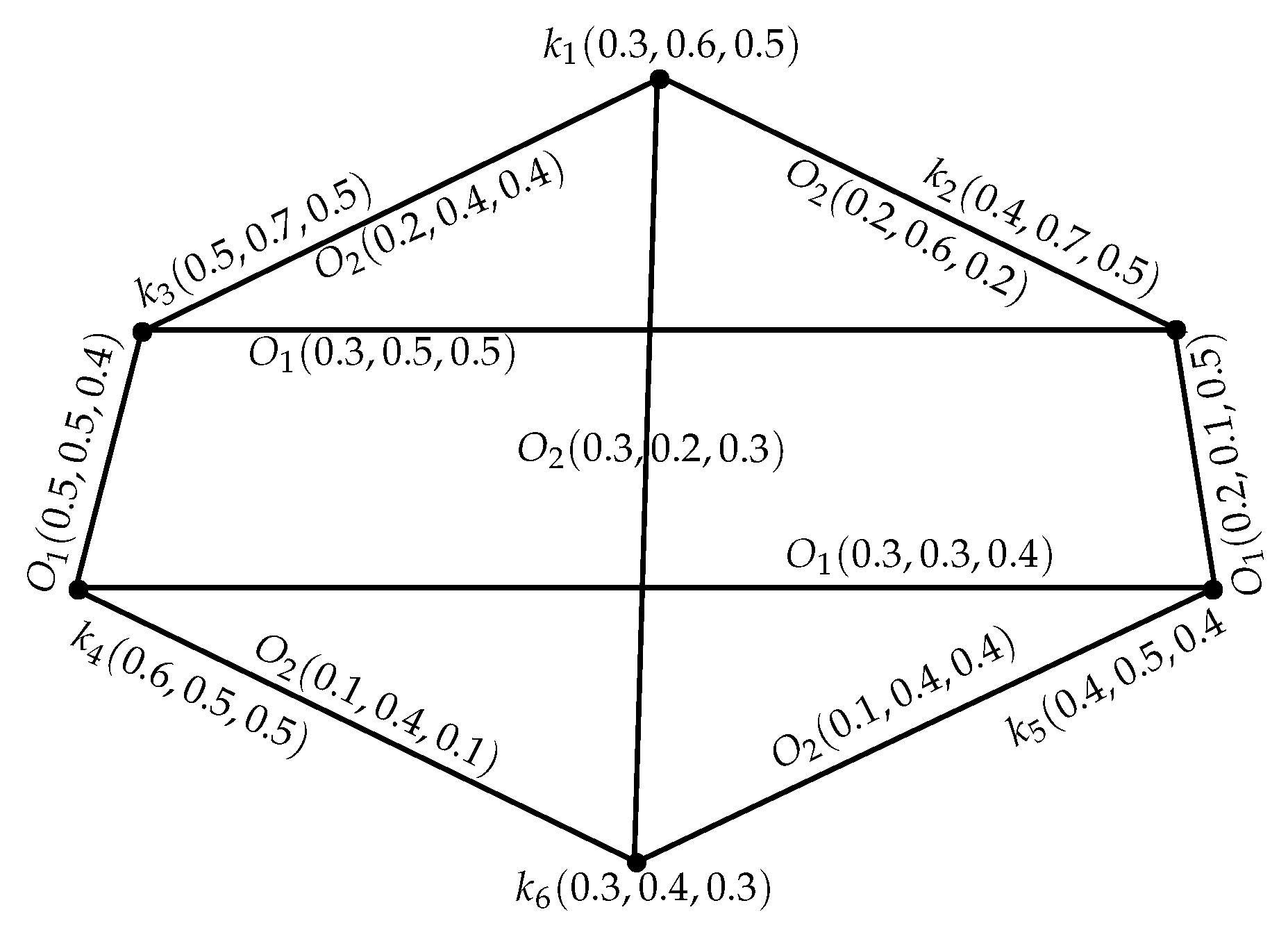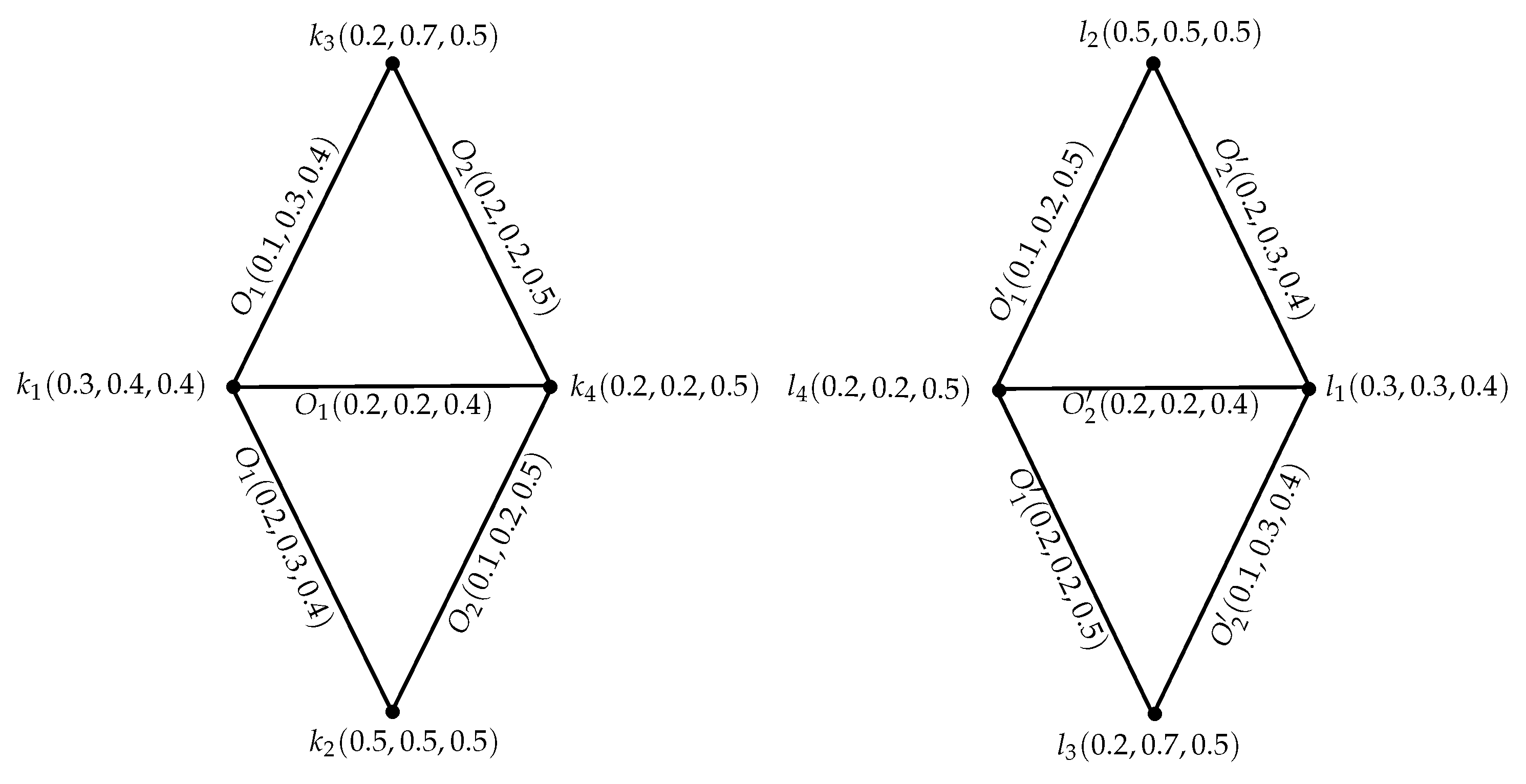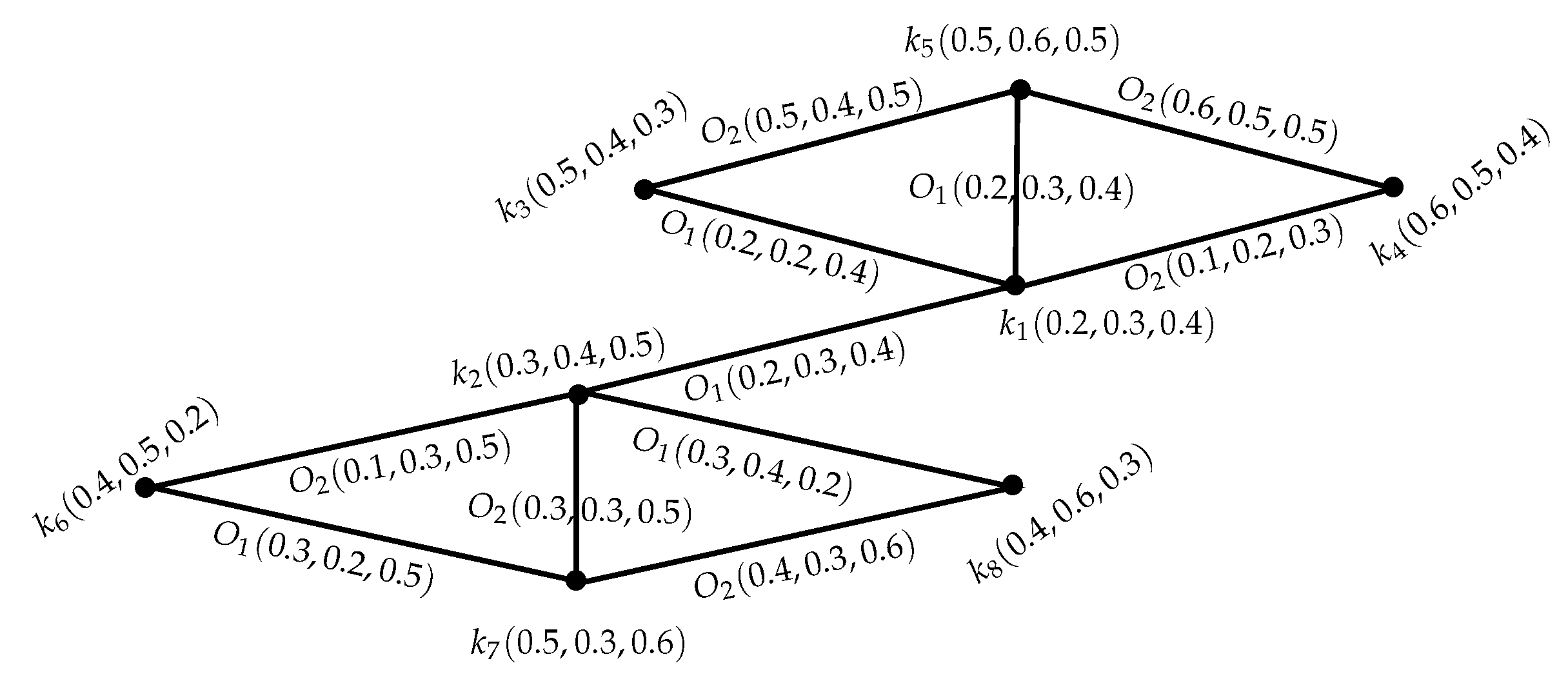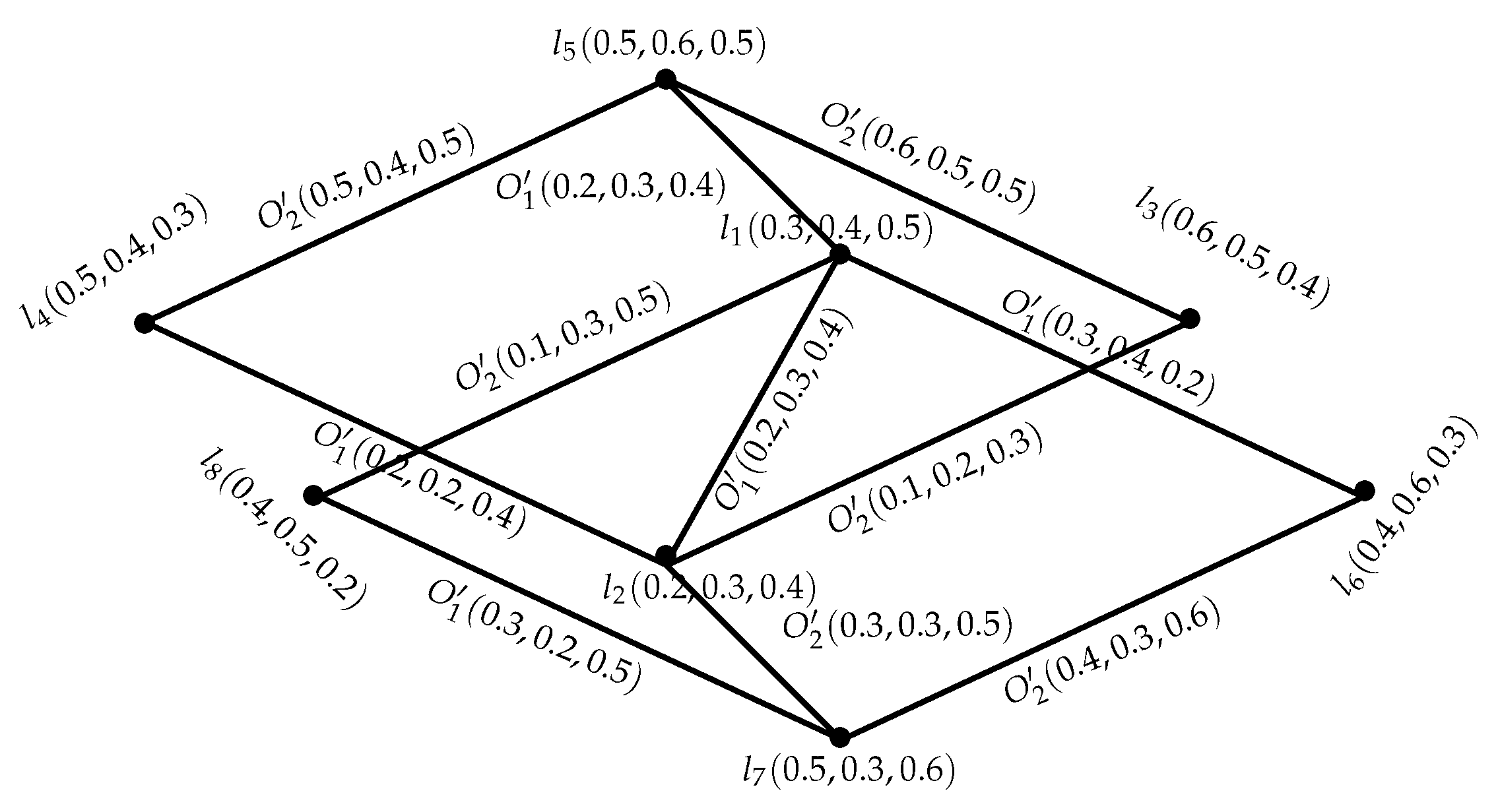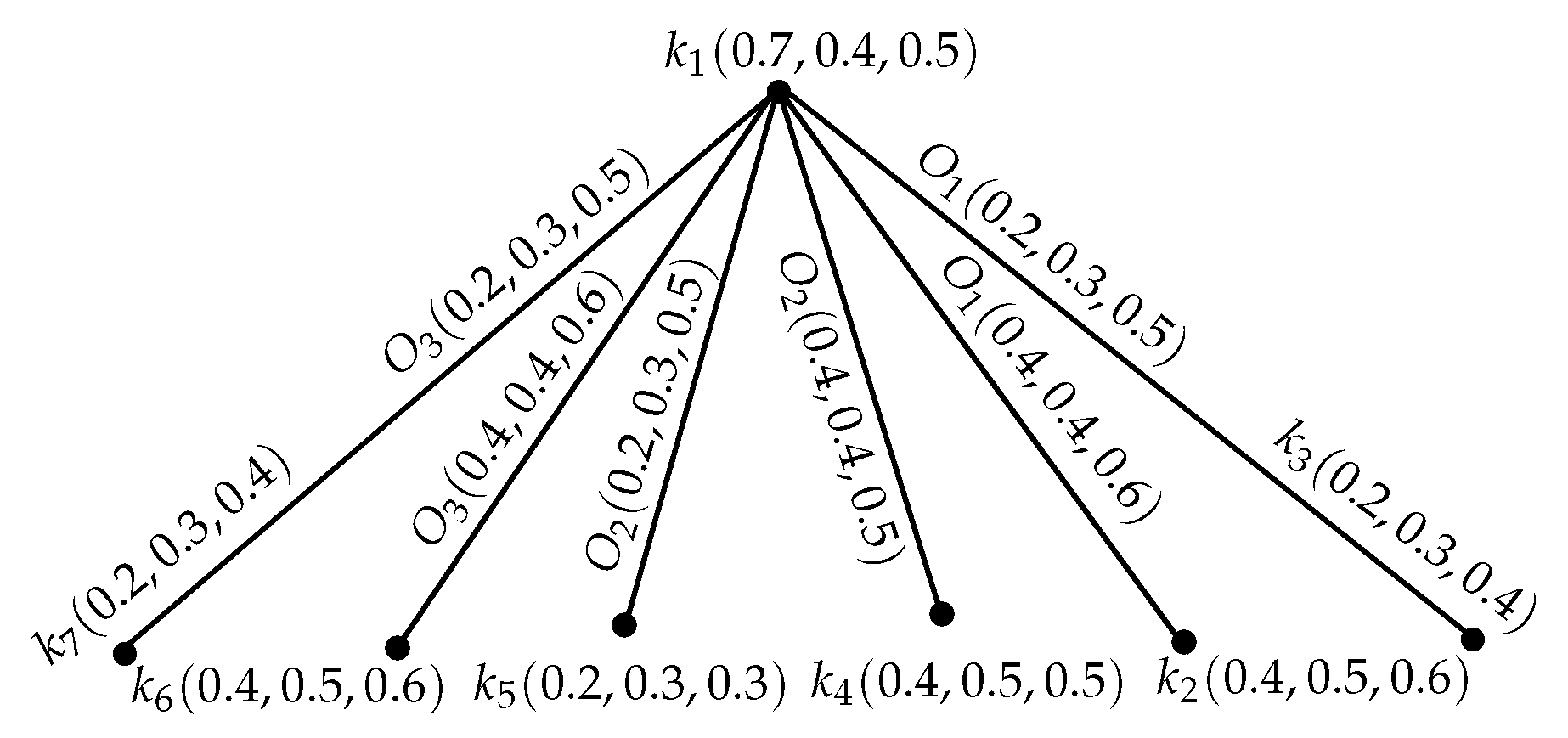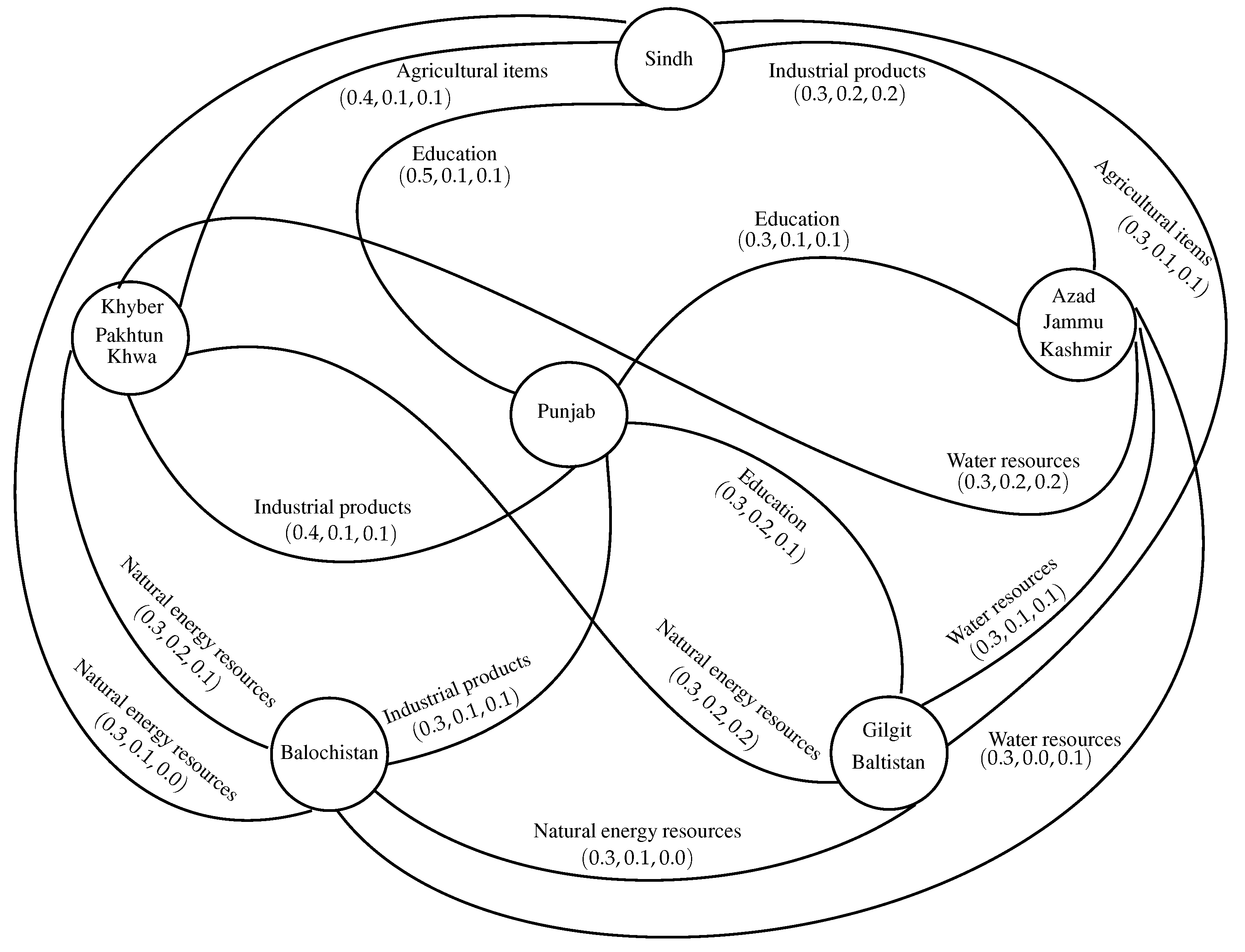2. Intuitionistic Neutrosophic Graph Structures
Sampathkumar [
46] introduced the graph structure, which is a generalization of an undirected graph and is quite useful in studying some structures like graphs, signed graphs, labeled graphs and edge colored graphs.
Definition 1. [46] A graph structure consists of a non-empty set V together with relations on V, which are mutually disjoint such that each , is symmetric and irreflexive. One can represent a graph structure in the plane, just like a graph where each edge is labeled as , .
Definition 2. [3] An ordered triple in in the universe of discourse V is called neutrosophic set, where , , : V→, and their sum is without any restriction. Definition 3. [4] An ordered triple in in a universe of discourse V is called single-valued neutrosophic set, where , , : V→, and their sum is restricted between 0 and 3. Definition 4. [47] Let V be a fixed set. A generalized intuitionistic fuzzy set I of V is an object having the form I=, where the functions and define the degree of membership and degree of nonmembership of an element , respectively, such that Definition 5. [9,10] An intuitionistic neutrosophic set can be stated as a set having the form , whereand . Definition 6. Let = be a graph structure(GS), and then = is called an intuitionistic neutrosophic graph structure (INGS), if O = and = are intuitionistic neutrosophic sets on P and , respectively, such that
- 1.
, ,
- 2.
- 3.
, , ,
where O is an underlying vertex set of and (h = 1, 2, …, r ) are underlying h-edge sets of .
Example 1. Consider a GS = such that O, , are IN subsets of , respectively, whereThrough direct calculations, it is easy to show that = is an INGS of as represented in Figure 1. Definition 7. Let = be an INGS of . If = is an INGS of such thatThen, is said to be an intuitionistic neutrosophic (IN) subgraph structure of INGS . Example 2. Consider an INGS = of GS = as represented in Figure 2. Through routine calculations, it can be easily shown that is an IN subgraph structure of INGS . Definition 8. An INGS = is called an IN induced-subgraph structure of by Q ⊆ P if Example 3. The INGS in the given Figure 3 is an IN induced-subgraph structure of an INGS in Figure 1. Definition 9. An INGS = is said to be a IN spanning-subgraph structure of if and Example 4. An INGS shown in Figure 4 is an IN spanning-subgraph structure of an INGS in Figure 1. Definition 10. Let = be an INGS. Then, is named as a IN -edge or shortly -edge, if or or or all these conditions are satisfied. As a result, support of is:. Definition 11. -path in an INGS = is a sequence of distinct vertices (except ) in P, such that is an IN -edge .
Definition 12. An INGS = is -strong for any if.
If is -strong for all , then is a strong INGS. Example 5. Consider an INGS = as represented in Figure 5. Then, is strong INGS, as it is and . Definition 13. An INGS = is a complete INGS, if
- 1.
is strong INGS.
- 2.
, for all h = 1, 2, …, r.
- 3.
For all , is a for some h.
Example 6. Let = be an INGS of GS = , such thatBy means of direct calculations, it is easy to show that is strong INGS. Moreover, , , , and every pair of vertices of P, is -edge or -edge or an -edge. Hence, is a complete INGS, that is, -complete INGS.
Definition 14. Let = be an INGS. The truth strength , falsity strength , and indeterminacy strength of an -path, = is defined as: Example 7. Consider an INGS = as in Figure 6. We found an -path = . So, = 0.2, = 0.1 and = 0.5. Definition 15. Let = be an INGS. Then,
-strength of connectedness of truth between k and l is defined as: = , such that = for and = = .
-strength of connectedness of indeterminacy between k and l is defined as: = , such that = for and = = .
-strength of connectedness of falsity between k and l is defined as: = , such that = for and = = .
Definition 16. An INGS = is called an -cycle if , is an .
Definition 17. An INGS = is an IN fuzzy -cycle (for any h) if
- 1.
is an -cycle.
- 2.
There exists no unique -edge in such that
or or
Example 8. Consider an INGS = as in Figure 6. Then, is an -cycle and IN fuzzy , since is an -cycle and no unique -edge satisfies the condition: or or Definition 18. Let = be an INGS and k a vertex in . Let be an IN subgraph structure of induced by such that
, = 0 = edges ; , , , ; = , = , = .
Then, k is IN fuzzy cut-vertex, for some h, ifand Note that k is an IN fuzzy cut-vertex, if , IN fuzzy cut-vertex, if and IN fuzzy cut-vertex, if .
Example 9. Consider an INGS = as represented in Figure 7 and = is an IN subgraph structure of an INGS , and we found it by deleting the vertex . The vertex is an IN fuzzy -I cut-vertex, since , and . Definition 19. Let = be an INGS and an .
Let be an IN fuzzy spanning-subgraph structure of , such that
= 0 = = , = , = , = , ∀ edges .
Then, is an IN fuzzy -bridge if
, and , for some .
Note that is an IN fuzzy bridge if , IN fuzzy bridge if and IN fuzzy bridge if .
Example 10. Consider an INGS = as shown in Figure 7 and = is IN spanning-subgraph structure of an INGS found by the deletion of -edge . Edge is an IN fuzzy -bridge. As = = , = = , = = Definition 20. An INGS = is an -tree, if is an . Alternatively, is an -tree, if there is a subgraph of induced by , which forms a tree.
Definition 21. An INGS = is an IN fuzzy -tree if has an IN fuzzy spanning-subgraph structure = such that, for all -edges not in ,
is an -tree, and , , .
In particular, is an IN fuzzy -T tree if , an IN fuzzy -I tree if
, and an IN fuzzy -F tree if .
Example 11. Consider an INGS = as shown in Figure 8. It is an -tree, not an -tree but it is IN fuzzy -tree because it has an IN fuzzy-spanning subgraph as an -tree, which is found by the deletion of -edge from . Moreover, , and Definition 22. An INGS = of graph structure = is said to be isomorphic to an INGS = of the graph structure = , if there is a pair , where is a bijective mapping and ψ is any permutation on this set such that;, h = 1,2,…,r. Example 12. Let = and = be two INGSs as shown in the Figure 9. and are isomorphic under , where is a bijective mapping and ψ is the permutation on , which is defined as , , and the following conditions hold: and, Definition 23. An INGS = of the graph structure = is identical with an INGS = of the graph structure = if is a bijective mapping such that, Example 13. Let = and = be two INGSs of the GSs = , = , respectively, as they are shown in Figure 10 and Figure 11. SVINGSs and are identical under is defined as :
, , , , , , , .
Moreover, = , = , = , and = , = , = , , .
Definition 24. Let = be an INGS and ψ is any permutation on and on set , that is, if and only if . If , for any h and
= , = ,
= , , then, , where t is chosen such that
, , . In addition, INGS is called a ψ-complement of an INGS , and it is symbolized as .
Example 14. Let , , , be IN subsets of P, , , , respectively.
Thus, = is an INGS of GS = . Let = , = , = , where ψ is permutation on . Now, for , respectively:
, , , , , , , , . So ,
, , , , , , , , . So ,
, , , , , , , , . This shows .
Hence, = is a ψ-complement of an INGS as presented in Figure 12. Proposition 1. A ψ-complement of an INGS = is a strong INGS. Moreover, if , where ; then, all -edges in an INGS become -edges in .
Proof. By definition of
-complement,
for
. For Expression
1.
As , and .
.
Hence, .
Furthermore,
gets a maximum value, when
is zero. Clearly, when
and
is an
-edge, then
attains zero value. Hence,
Similarly, for I, the results are:
Since , and .
.
Therefore, ∀ i.
Value of the
is maximum when
gets zero value. Clearly, when
and
is an
-edge, then
is zero. Thus,
On a similar basis for F in -complement, the results are:
Since , and .
.
Hence, .
Furthermore,
is maximum, when
is zero. Definitely, when
and
is an
-edge, then
is zero. Hence,
Expressions (
4)–(
6) give the required proof.
◻
Definition 25. Let be an INGS and ψ be any permutation on . Then,
- (i)
is a self-complementary INGS if is isomorphic to ;
- (ii)
is a strong self-complementary INGS if is identical to .
Definition 26. Let = be an INGS. Then,
- (i)
is a totally self-complementary INGS if is isomorphic to , ∀ permutations ψ on ;
- (ii)
is a totally-strong self-complementary INGS if is identical to , ∀ permutations ψ on .
Example 15. INGS = in Figure 13 is totally-strong self-complementary INGS. Theorem 1. A strong INGS is a totally self-complementary INGS and vice versa.
Proof. Consider any strong INGS
and Permutation
on {1,2, …, r}. By proposition 1,
-complement of an INGS
=
is a strong INGS. Moreover, if
, where
, then all
-edges in an INGS
become
-edges in
, this leads
Therefore, under
(identity mapping),
and
are isomorphic, such that
and
, for
; h,t =
.
For each permutation on , this holds. Hence, is a totally self-complementary INGS.
Conversely, let
is isomorphic to
for each permutation
on
. Then, by definitions of
-complement of INGS and isomorphism of INGS, we have
, t = 1,2,...,r. Hence,
is strong INGS.
◻
Remark 1. Each self-complementary INGS is a totally self-complementary INGS.
Theorem 2. If = is a totally strong self-complementary GS and is an IN subset of P, where are the constant functions, then any strong INGS of with IN vertex set O is necessarily totally-strong self-complementary INGS.
Proof. Let
u,
v and
w be three constants, and
Since
is a totally strong self-complementary GS, so, for each permutation
on
there exists a bijective mapping
, such that, for each
-edge
, (g(k)g(l)) [a
-edge in
] is a
-edge in
. Thus, for every
-edge
, (g(k)g(l)) [an
-edge in
] is an
-edge in
.
Moreover,
is a strong INGS, so
and
,
.
This shows that is a strong self-complementary INGS. This exists for each permutation and on set , thus is a totally strong self-complementary INGS. Hence, required proof is obtained.
◻
Remark 2. Converse of the Theorem 2 may or may not true, as an INGS shown in Figure 2 is totally strong self-complementary INGS, and it is also a strong INGS with a totally strong self-complementary underlying GS but , , are not the constant-valued functions. 3. Application
First, we explain the general procedure of this application by the following algorithm.
Algorithm: Crucial interdependence relations
- Step 1.
Input vertex set P = and IN set O defined on P.
- Step 2.
Input IN set of interdependence relations of any vertex with all other vertices and calculate T, F, and I of every pair of vertices by using, , , .
- Step 3.
Repeat the Step 2 for every vertex in P.
- Step 4.
Define relations on set P such that is a GS.
- Step 5.
Consider an element of that relation, for which its value of T is comparatively high, and its values of F and I are lower than other relations.
- Step 6.
Write down all elements in relations with T, F and I values, corresponding relations are IN sets on , respectively, and is an INGS.
Human beings, the main creatures in the world, depend on many things for their survival. Interdependence is a very important relationship in the world. It is a natural phenomenon that nobody can be 100% independent, and the whole world is relying on interdependent relationships. Provinces or states of any country, especially of a progressive country, can not be totally independent, more or less they have to depend on each other. They depend on each other for many things, that is, there are many interdependent relationships among provinces or states of a progressive country—for example, education, natural energy resources, agricultural items, industrial products, and water resources, etc. However, all of these interdependent relationships are not of equal importance. Some are very important to run the system of a progressive country. Between any two provinces, all interdependent relationships do not have the same strength. Some interdependent relationships are like the backbone for the country. We can make an INGS of provinces or states of a progressive country, and can highlight those interdependent relationships, due to which the system of the country is running properly. This INGS can guide the government as to which interdependent relationships are very crucial, and they must try to make them strong and overcome the factors destroying or weakening them.
We consider a set P of provinces and states of Pakistan:
P = {Punjab, Sindh, Khyber Pakhtunkhawa(KPK), Balochistan, Gilgit-Baltistan, Azad Jammu and Kashmir(AJK) }. Let
O be the IN set on
P, as defined in
Table 1.
In
Table 1, symbol
T demonstrates the positive role of that province or state for the strength of the Federal Government, and symbol
F indicates its negative role, whereas
I denotes the percentage of ambiguity of its role for the strength of the Federal Government. Let us use the following alphabets for the provinces’ names:
PU = Punjab, SI = Sindh, KPK = Khyber Pakhtunkhwa, BA = Balochistan, GB = Gilgit-Baltistan, AJK = Azad Jammu and Kashmir. For every pair of provinces of Pakistan in set
P, different interdependent relationships with their
T,
I and
F values are demonstrated in
Table 2,
Table 3,
Table 4,
Table 5 and
Table 6.
Many relations can be defined on the set P, we define following relations on set P as:
= Education, = Natural energy resources, = Agricultural items, = Industrial products, = Water resources, such that is a GS. Any element of a relation demonstrates a particular interdependent relationship between these two provinces. As is GS; this is why any element can appear in only one relation. Therefore, any element will be considered in that relationship, whose value of T is high, and values of I, F are comparatively low, using the data of above tables.
Write down T, I and F values of the elements in relations according to the above data, such that , , , , are IN sets on relations , , , , , respectively.
Let = ;
= {(Sindh, Balochistan), (Khyber Pakhtunkhawa, Balochistan), (Balochistan, Gilgit-Baltistan), (Khyber Pakhtunkhawa, Gilgit-Baltistan)};
= {(Sindh, Khyber Pakhtunkhwa), (Gilgit-Baltistan, Sindh)};
= ;
= .
Let = ,
= ,
= ,
= ,
.
Obviously, (
O,
,
,
,
,
) is an INGS as shown in
Figure 14.
Every edge of this INGS demonstrates the most dominating interdependent relationship between those two provinces—for example, the most dominating interdependent relationship between Punjab and Gilgit-Baltistan is education, and its T, F and I values are 0.3, 0.2 and 0.1, respectively. It shows that education is the strongest connection bond between Punjab and Gilgit-Baltistan; it is stable, unstable, and unpredictable or uncertain. Using INGS, we can also elaborate the strength of any province, e.g., Punjab has the highest vertex degree for interdependent relationship education, and Balochistan has the highest vertex degree for the interdependent relationship natural energy resources. This shows that the strength of Punjab is education, and the strength of Balochistan is the natural energy resources. This INGS can be very helpful for Provincial Governments, and they can easily estimate which kind of interdependent relationships they have with other provinces, and what is the percentage of its stability and instability. It can also guide the Federal Government in regards to, between any two provinces, which relationships are crucial and what is their status. The Federal Government should be conscious of making decisions such that the most crucial interdependent relationships of its provinces are not disturbed and need to overcome the counter forces that are trying to destroy them.

